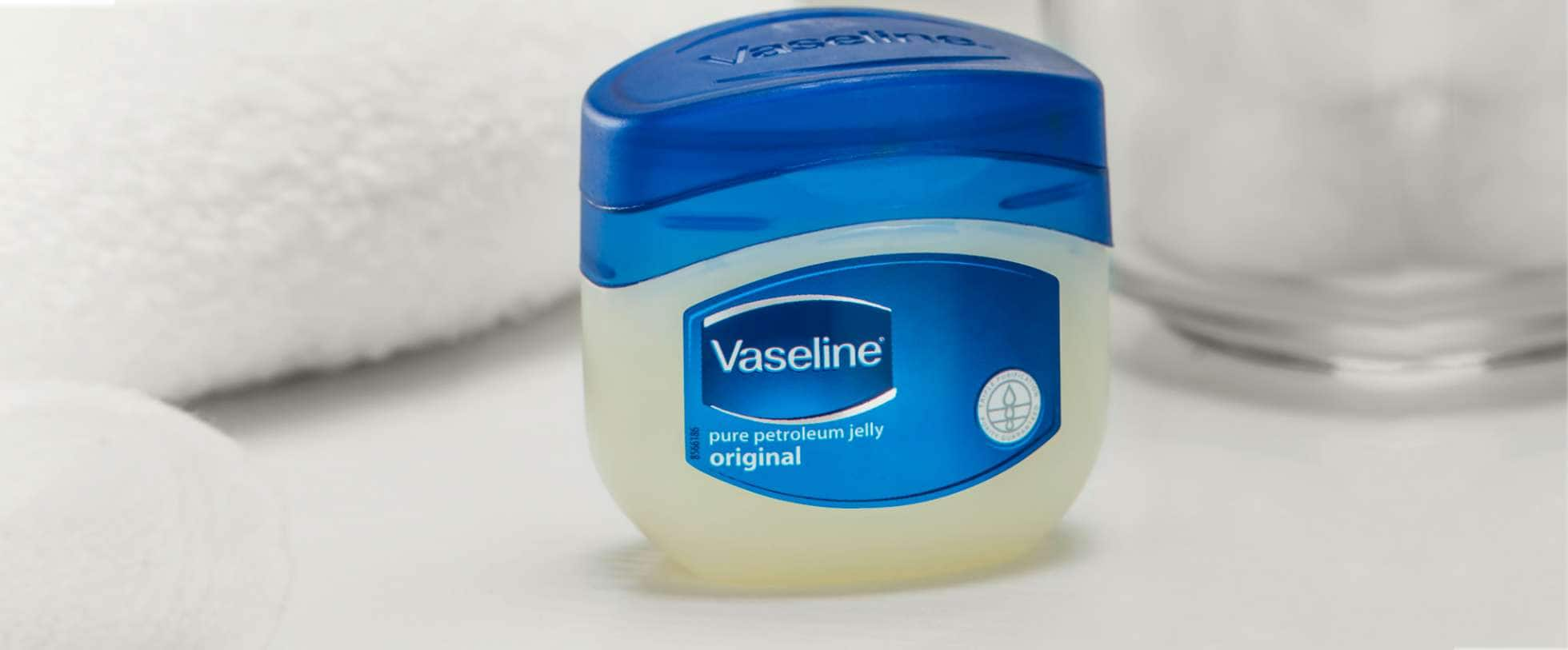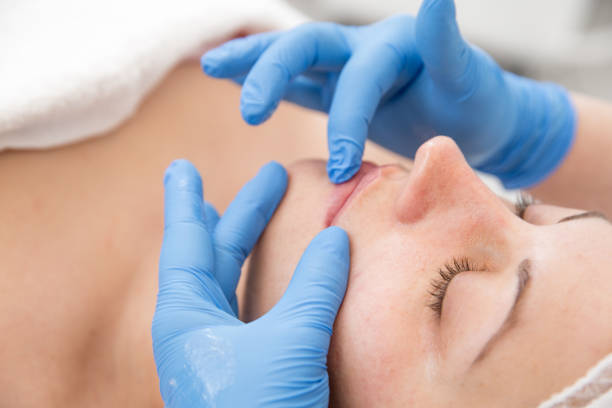For generations, petroleum jelly has been a ubiquitous presence in medicine cabinets and homes alike. But have you ever stopped to wonder, is petroleum jelly the same as Vaseline? Or are these two terms merely interchangeable? That’s exactly what I’m going to address in this article. But first, we will start with a brief overview of these moisturizers before moving on to their differences and similarities. Scroll down!

WHAT IS PETROLEUM JELLY?
Petroleum jelly is a solid, colorless, odorless, and tasteless substance with high viscosity, created by a unique combination of mineral oil and wax derived from petroleum. This product forms an effective protective layer on the skin, preventing water loss and leaving the skin feeling soft and smooth. Moreover, petroleum jelly plays a crucial role in shielding wounds, preventing the intrusion of bacteria, and aiding in the rapid healing of injuries. It is particularly an ideal choice for soothing irritated skin, such as after sunburn or in the case of chapped skin.

WHAT IS VASELINE?
Vaseline is a trade name of a form of petroleum jelly, which is highly pure and has other components such as minerals and microcrystalline wax. This is a common household product. We use it as a skin protecting agent, lotion, cleansing the skin, etc. This compound is smoother than normal petroleum jelly. In addition, it has a fragrance similar to baby powder.

IS VASELINE A GOOD MOISTURIZER?
Yes, Vaseline, which is a brand of petroleum jelly, is known for its excellent moisturizing properties. Here are some reasons why Vaseline is considered a good moisturizer:
Creates a Barrier
Vaseline forms a protective barrier on the skin, preventing moisture loss. This barrier helps to lock in hydration and keep the skin moisturized.
Soothes Dry Skin
Vaseline is effective in soothing and moisturizing dry and rough skin. It can be applied to areas with dry patches, such as elbows, knees, and heels.
Chapped Lips
It is commonly used to moisturize and heal chapped lips. Applying a small amount of Vaseline to the lips helps to keep them hydrated and prevent further drying.
Cuticle Care
Vaseline can be massaged into the cuticles to soften and moisturize them. This is particularly beneficial for individuals with dry or cracked cuticles.
Minor Wounds
It can be applied to minor cuts, scrapes, or wounds to create a protective barrier and promote the healing process.
Makeup Removal
Vaseline can act as a gentle makeup remover, especially for stubborn makeup like waterproof mascara. Applying a small amount on a cotton pad helps to dissolve makeup.
Long-Lasting Moisture
Due to its thick consistency, Vaseline provides long-lasting moisture. It is often used as a nighttime moisturizer to hydrate the skin while sleeping.
CAN PETROLEUM JELLY BE USED AS A MOISTURIZER?
Yes, petroleum jelly can be used as a moisturizer. Petroleum jelly, such as Vaseline, is known for its excellent moisturizing properties. It creates a protective barrier on the skin, preventing moisture loss and helping to keep the skin hydrated. Here are some ways in which petroleum jelly can be used as a moisturizer:
Relieving Dry Skin Discomfort
To effectively alleviate discomfort and moisturize dry skin, gently apply a thin layer of petroleum jelly to areas such as elbows, knees, and heels. The protective layer helps retain moisture, preventing dehydration and providing a soothing and gentle feel to the skin. This is particularly beneficial when the skin is experiencing dryness, roughness, and requires dedicated nourishment.
Caring for Chapped Lips
To alleviate discomfort and maintain moisture for chapped lips, you can directly apply petroleum jelly to the affected area. This not only helps reduce pain but also keeps the lips soft and maintains moisture. Additionally, petroleum jelly can be blended with other lip balm ingredients to enhance moisturizing effectiveness and care for your lips. This is particularly beneficial when caring for lips that require special treatment and nourishment.
Softening Rough Skin
Regularly using petroleum jelly on rough or patchy areas, such as elbows and heels, brings about effective softening and smoothing results. The protective layer of petroleum jelly helps retain moisture, supplies nutrients, and soothes dry and rough skin areas, promoting efficient regeneration and restoration of the skin. This care is particularly crucial for maintaining softness and health in areas of the skin that are regularly exposed to and heavily impacted by the surrounding environment.
Night Moisturizer
Creating a night moisturizer for your face is a crucial step in skincare. You can apply a small amount of petroleum jelly to clean and dry skin before going to bed to optimize the moisturizing process. The protective layer of petroleum jelly will keep your skin soft and prevent moisture loss overnight. This not only helps in rejuvenating the skin after a tiring day but also enhances the natural recovery process, so you wake up with fresh and vibrant skin.
Protection Against Harsh Weather
Applying petroleum jelly to your skin in harsh weather conditions is not only an effective protective measure but also helps maintain the health of your skin. The protective layer created by petroleum jelly will mitigate the impact of cold winds and low temperatures on your skin, preventing moisture loss and keeping your skin soft and moisturized. This is particularly crucial when your skin is exposed to harsh weather conditions, where dryness and damage are more likely to occur. In this way, petroleum jelly not only shields your skin from external factors but also ensures that your skin remains in its best condition.
IS petroleum jelly the same as vaseline?
No, petroleum jelly and Vaseline are not exactly the same. While petroleum jelly is a general term referring to semi-solid mixture of hydrocarbons obtained from petroleum, Vaseline is the brand name for a specific type of petroleum jelly. Here are key differences between them:
| Compare | Petroleum jelly | Vaseline |
| Source | Derived from petroleum, a fossil fuel | Can have various sources, including natural ingredients, plant extracts, and synthetic compounds |
| Composition | Primarily composed of hydrocarbons, with a mixture of mineral oils and waxes.May go through refining processes to remove impurities. | Includes a variety of ingredients such as water, emollients, humectants, occlusives, and sometimes additives like vitamins, antioxidants, and fragrances.Emollients soften and smooth the skin.Humectants attract and retain moisture.Occlusives create a barrier to lock in moisture |
| Characteristics | Colorless, odorless, and tasteless.Has a thick, semi-solid consistency.Forms a protective barrier on the skin’s surface.Provides a barrier against moisture loss. | Can come in various forms, including lotions, creams, and ointments. Have specific formulations for different skin types (e.g., oily, dry, sensitive). |
| Purpose | Often used to prevent dryness and chapping.Acts as a lubricant and barrier for the skin. | Addresses specific skin concerns (e.g., dryness, aging, acne).Provides a broader range of benefits due to diverse ingredients.Offers targeted solutions based on skin type and conditions |
Similarities between petroleum jelly and vaseline
Essentially, both petroleum jelly and Vaseline have similar ingredients and properties. They are both colorless, odorless, tasteless, wax-like substances with the ability to form a protective layer on the skin. This layer helps prevent water loss, retains moisture, and shields the skin from harmful environmental factors. Vaseline is made from 100% pure petroleum jelly, distilled three times to remove impurities. This makes it safer and more effective compared to other petroleum jelly types that may contain additional ingredients such as fragrances, preservatives, or other additives.”
Conclusion
Although many people commonly refer to both products as “Vaseline,” in reality, Vaseline is a specific brand of petroleum jelly, and there are some minor differences between them. Throughout this article, we have outlined the distinct characteristics of these two products, emphasizing that both have the ability to create a protective barrier on the skin, aiding in moisture retention and softening the skin. If you are seeking a simple and effective moisturizing product, both Vaseline and petroleum jelly are popular and economical choices. However, if you have specific requirements for skincare or sensitive skin, the choice between them may depend on your individual preferences and the current condition of your skin.
FAQS
- Can I use petroleum jelly on my face?
Yes, you can use petroleum jelly on your face, but it’s important to do so with caution and in moderation. Petroleum jelly, such as Vaseline, is known for its occlusive properties, which means it forms a barrier on the skin, helping to lock in moisture.
- What are the disadvantages of petroleum jelly on skin?
Excessive and improper usage of petroleum jelly can result in certain side effects such as clogged pores, pneumonia, allergies, and infections. You need to avoid using petroleum jelly if you have acne-prone, oily, or combination skin.
- Does Vaseline increase pore size?
No, Vaseline does not increase pore size. In fact, it’s considered non-comedogenic, meaning it won’t clog your pores. This makes it a safe and suitable option for most skin types, including those with acne-prone skin.
- Is it safe to put Vaseline in your eyes?
No, it is not safe to put Vaseline or any petroleum-based product directly into your eyes. While Vaseline is generally considered safe for external use, it should not come into contact with the eyes.







